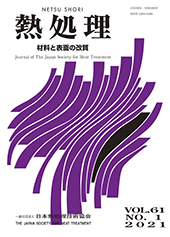
- |<
- <
- 1
- >
- >|
-
Takuro MASUMURA, Tatsuya HONDA, Kosuke NARIDOMI, Shohei URANAKA, Toshi ...2021Volume 61Issue 3 Pages 112-118
Published: 2021
Released on J-STAGE: July 06, 2021
JOURNAL FREE ACCESSAge hardening in stable austenitic stainless steel wires with a chemical composition of Fe-18%Cr-12%Ni and different N contents was investigated to clarify the role of N. Age hardening could be enhanced by increasing the drawing ratio and N content. The highest age-hardening effect was observed at 800 K in the N-bearing specimens. In addition, severe drawing induced low-temperature age hardening at 450–600 K. Differential scanning calorimetry (DSC) analysis revealed that age hardening at 800 K may be attributed to particle dispersion strengthening by Cr2N. Meanwhile, the exothermic peaks observed at 450–600 K were controlled by the pipe diffusion of N. However, nitride precipitates and clusters could not be detected by 3D atom probe anaysis, which implies the formation of atomic-scale N products, such as I-S pairs, at the dislocations.
View full abstractDownload PDF (1850K) -
Yuta MOTOMURA, Tatsuya TOKUNAGA, Hidenori ERA, Kazuhisa SHOBU, Mitsuhi ...2021Volume 61Issue 3 Pages 119-125
Published: 2021
Released on J-STAGE: July 06, 2021
JOURNAL FREE ACCESSTo clarify the effect of alloying elements (Me) on the grain boundary segregation behavior of nitrogen (N) in α-iron, the grain boundary segregation of N and alloying elements in the Fe–1.0 at.%Me–N (Me:Al, Ti, V, Cr, Mn, Nb or Mo) ternary system was thermodynamically evaluated using the parallel tangent law proposed by Hillert. In this study, the Gibbs energy of the liquid phase in the Fe–1.0 at.%Me–N ternary system was applied to that of the grain boundary. The calculations predicted co-segregation of N and alloying elements for alloys with Al, Ti, V, Cr or Nb additions. In contrast, co-segregation behavior was not predicted in the case of Mn or Mo addition. The tendency of co-segregation of N and alloying elements corresponded well with the formation tendency of metal nitrides.
View full abstractDownload PDF (2466K)
- |<
- <
- 1
- >
- >|